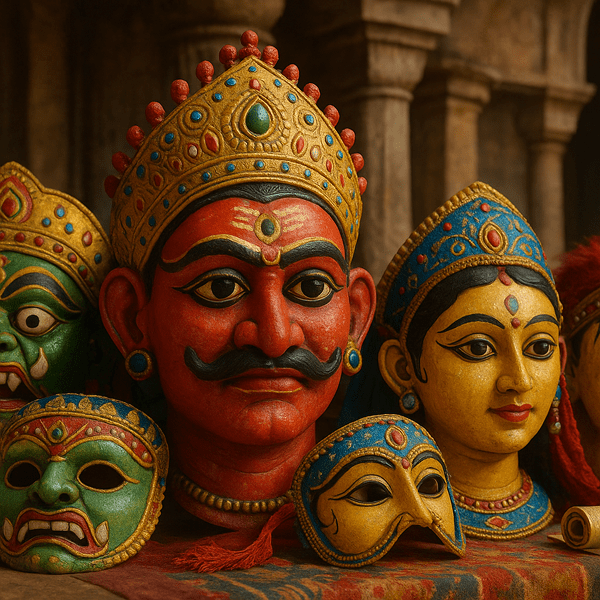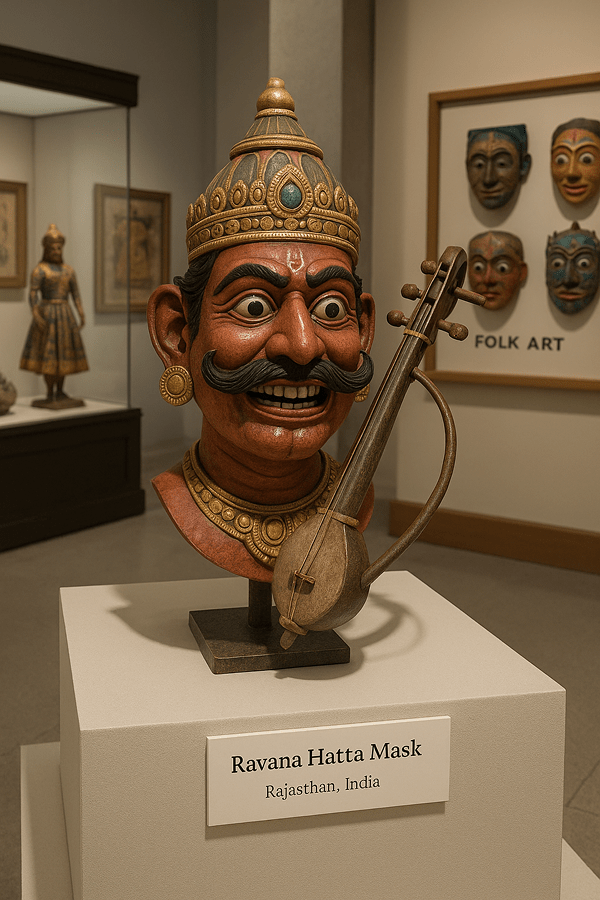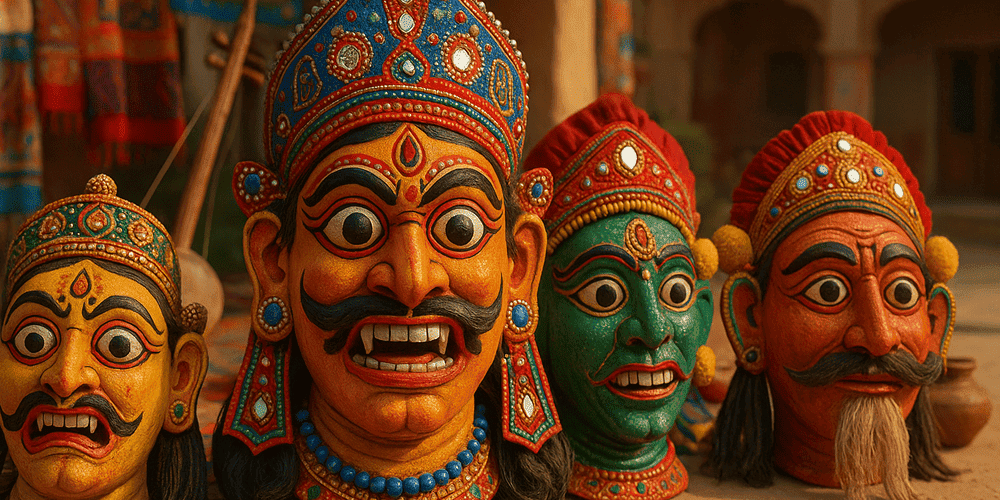Ravanahattha Masks are a unique and visually striking part of India’s rich tradition of mask-making, particularly associated with the folk and performing arts of Rajasthan and Gujarat. These masks are instantly recognizable for their elaborate designs, vivid colors, and dramatic expressions that reflect both mythological and local themes. Typically crafted from papier-mâché or wood, Ravanahattha Masks are distinguished by bold facial features, ornate decorations, and an overall sense of theatrical flair. While closely linked to traditional music performances — especially those featuring the ancient string instrument called the ravanahattha — these masks are also prominent in regional festivals and ritual dramas. The tradition of making and using Ravanahattha Masks dates back several centuries, deeply rooted in the cultural landscape of Northwestern India.
Historical Origins: The Story Behind Ravanahattha Masks
The history of Ravanahattha Masks is intertwined with the evolution of folk performing arts in Rajasthan and Gujarat. The name “Ravanahattha” is derived from the ravanahattha, an ancient bowed string instrument, believed to have been created by Ravana, the legendary king from the Hindu epic Ramayana. Over time, the instrument became a symbol of folk storytelling, and masks began to be used in performances to visually enhance narratives. Early references to masks resembling Ravanahattha Masks can be found in temple carvings and historical manuscripts from the medieval period. As local theatre forms like Bhavai and puppet shows evolved, so did the use of expressive masks, which added drama and symbolism to performances. The design and function of these masks have adapted over centuries, reflecting changes in ritual, music, and popular entertainment. Today, Ravanahattha Masks are considered an important part of the region’s living heritage and are displayed in cultural museums and festivals.
Cultural Significance and Symbolism: Meaning of Ravanahattha Masks
In their native culture, Ravanahattha Masks represent more than just artistic props — they are imbued with deep symbolic meaning. Each mask can embody deities, demons, legendary heroes, or folk characters, serving as a medium for storytelling and spiritual transformation. In many performances, donning a Ravanahattha Mask is believed to invoke the spirit or qualities of the character portrayed, allowing the performer to channel mythic power or moral lessons. The masks are often used in rituals to bless the community, ward off evil, and celebrate local legends. Stories surrounding Ravanahattha Masks frequently reference ancient myths, such as the legend of Ravana and his musical prowess. Socially, these masks play a key role in uniting communities during festivals, music gatherings, and dramatic events, reinforcing shared values and cultural identity. For those interested in the diversity of Indian masking traditions, it is fascinating to compare Ravanahattha Masks with other iconic forms, such as Chhau Masks from Eastern India.

Materials and Craftsmanship: Creating Ravanahattha Masks
Ravanahattha Masks are traditionally made using materials like papier-mâché, lightweight wood, natural fibers, and occasionally metal or cloth for embellishments. The mask-making process begins with molding or carving the basic facial structure, followed by layering and shaping to achieve the desired features. Skilled artisans use knives, chisels, and brushes to define intricate patterns, exaggerated eyes, and expressive mouths. Once the base is prepared, the mask is painted with vibrant natural pigments — most commonly reds, golds, blues, and greens — to create a striking visual effect. Decorative elements, such as mirrors, beads, and sequins, may be added for extra flair. Regional differences are evident: masks from Rajasthan often feature intricate mirror work and bold lines, while those from Gujarat may have more subdued color palettes and subtle detailing. Each mask’s color and motif carry symbolic meanings, such as red for power, gold for divinity, and blue for protection.
Functions and Use: Ravanahattha Masks in Ritual and Performance
The primary use of Ravanahattha Masks is in folk music and dance performances, especially those involving the ravanahattha instrument. During these events, performers wear masks to embody mythological or folk characters, bringing stories to life through music, movement, and drama. The masks are also used in religious rituals, where they serve as vessels for spiritual invocation or protection. Festivals such as Holi, Navratri, and local temple fairs often feature masked performances that attract large audiences. Over time, the use of Ravanahattha Masks has expanded to include educational programs, museum exhibitions, and contemporary stage productions. While their ritual significance remains strong, modern adaptations have allowed these masks to become symbols of regional identity and artistic innovation.
Regional Variations: Diversity of Ravanahattha Masks
There are several regional variations of Ravanahattha Masks, reflecting the diverse cultural landscapes of Rajasthan and Gujarat. In Rajasthan, masks tend to be larger and more ornate, with a focus on dramatic expressions and elaborate decorations. In contrast, Gujarat’s masks are often smaller, with more intricate carving and muted colors. Some regions incorporate elements from local folklore, resulting in unique designs that differ even between neighboring villages. When compared with similar traditions in India, such as the Chhau Masks of West Bengal and Odisha, Ravanahattha Masks stand out for their connection to music and their distinct visual style. These local adaptations highlight the importance of regional identity in Indian mask-making.
Famous Examples and Collections: Where to See Ravanahattha Masks
Notable Ravanahattha Masks can be found in museums such as the City Palace Museum in Udaipur, the Rajasthan State Museum, and the Gujarat State Museum. These institutions showcase a variety of masks, costumes, and musical instruments that offer insights into the region’s performing arts. Private collectors and folk art galleries also display rare and antique Ravanahattha Masks, some of which are considered masterpieces of traditional craftsmanship. Online platforms like toddmasks.com provide educational content and curated selections for enthusiasts interested in exploring or acquiring authentic Indian masks.

Influence on Art and Culture: Ravanahattha Masks in Contemporary Creativity
The influence of Ravanahattha Masks extends into many aspects of Indian art and culture. Their bold designs and symbolic motifs inspire modern painters, sculptors, and fashion designers, who reinterpret traditional forms in contemporary contexts. Ravanahattha Masks appear in Indian literature, cinema, and music, serving as metaphors for transformation, power, and heritage. In stage design and modern performances, mask motifs are used to evoke folk traditions and celebrate regional creativity. The preservation of Ravanahattha Masks plays a vital role in maintaining India’s cultural diversity and inspiring new generations of artists and performers.
Modern Status and Preservation: Keeping the Tradition Alive
Today, the tradition of Ravanahattha Mask-making is upheld by master artisans, craft cooperatives, and cultural organizations in Rajasthan and Gujarat. Training programs, workshops, and educational festivals help transmit skills to younger generations. Modern innovations, such as the use of new materials or digital design, complement traditional craftsmanship without sacrificing authenticity. Efforts by museums, NGOs, and local governments to document, exhibit, and support mask-making ensure the continuity of this ancient art form. Public performances and masterclasses encourage community participation and raise awareness of the cultural value of Ravanahattha Masks.
Collecting and Acquisition: The Market for Ravanahattha Masks
The market for Ravanahattha Masks is vibrant, with both antique and contemporary examples available for collectors. Authentic masks can be purchased from folk art markets, museum shops, and reputable online galleries like toddmasks.com. Prices vary depending on age, craftsmanship, provenance, and ritual significance, with rare or antique masks commanding higher values. When collecting, it is important to verify the mask’s origin and authenticity, and to support ethical practices that respect cultural heritage and benefit artisan communities. Guidance from experts and documentation can help buyers avoid replicas and ensure the preservation of traditional knowledge.
